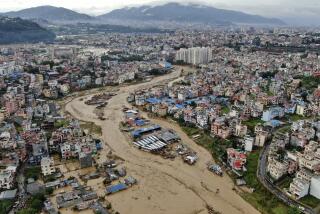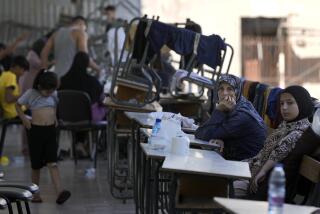Nine months after Nepal quake, political squabbles keep thousands displaced
- Share via
Reporting from KATMANDU, Nepal — Aarti Tamang remembers the sound of boulders crashing down from the hills around her family’s house and the feeling of her two children’s hands as she clasped them tightly in her own.
Nearly nine months after the 7.8 earthquake that flattened their home and devastated Nepal, the Tamang family is still looking for a permanent place to live.
The family of four — along with hundreds of families from their village of Tatopani in the hard-hit northern Sindhupalchowk district — sought refuge in the capital, Katmandu, days after the April 25 quake that killed more than 8,000 people.
For seven months they squatted on the grounds of a school in the capital, until they were forced to move to a rented room they can barely afford. Like thousands displaced by the quake, Tamang hoped to have returned home by now, but delays in the government-led rehabilitation effort have left them with no option but to remain in Katmandu, looking for work and waiting for assistance.
“We thought this was how we would die, crushed by the rocks falling from above us, so coming to Katmandu after the earthquake was a relief at first,” said Tamang, a petite 25-year-old who looks much older. “But living in Katmandu hasn’t been easy either.”
Almost 8,000 people are living in temporary shelters across the capital, on top of thousands of others who are renting rooms or crammed in with family members, city officials say. The influx has put more pressure on water and waste management systems in a city of 2.5 million whose infrastructure was already struggling.
“Katmandu’s water supply cannot even meet half of the city’s demand, so one can imagine how bad the situation is in the temporary camps with no proper water or waste management system in place,” said Rudra Singh Tamang, chief executive of the city administration.
An estimated 2 million people nationwide whose homes were damaged have not received $2,000 housing reconstruction grants because Nepal’s National Reconstruction Authority, which is overseeing the rehabilitation effort, was suspended until last month because of political squabbling. The grants were to be paid in part from $4.1 billion pledged by international donors, which has also not been spent.
An urban planning expert, Sushil Gyewali, was named to head the agency in December and vowed to jump-start reconstruction and disbursement of the money.
In the meantime, protests over Nepal’s new constitution have sparked a crisis at the Indian border, disrupting supplies of fuel and basic goods from the country’s most important trading partner. Costs of cooking gas have soared fivefold, according to the United Nations World Food Program, which says the border blockages have also hampered its efforts to deliver food assistance.
Nepal’s central bank said this month that inflation had reached a 40-month high of 11.6% because of disruptions in the transportation system.
Thousands of people in 14 districts are enduring winter in makeshift shelters. Families have received only $150 grants and many are still waiting for additional $100 payments the government pledged to help them buy winter clothes.
In Katmandu, where more than 100,000 houses were damaged, urban planners fear the creation of new slums. The misery could accelerate the flight of Nepalese who become migrant workers abroad, experts say.
“If the reconstruction work doesn’t commence and if the supplies disruption is not resolved soon, then more people will flock into urban centers and eventually seek employment overseas,” said Chandan Sapkota, a former economics officer with Asian Development Bank in Katmandu.
Rita Lama, who moved with her husband to a temporary shelter in Katmandu after their Nuwakot village home was destroyed, said they have not been able to find a safe and affordable home in the city.
“My husband has been looking for work, and we are running out of our savings,” said Lama, 40.
Tamang complained of the overcrowded capital — its polluted air, and shortage of water — but said it is the only place where they have a hope of rebuilding their lives. She used to run a small hotel in Tatopani, near the Chinese border, while her husband, Jit Bahadur Tamang, worked as a driver along the coiled mountain highway.
The earthquake destroyed her business, and landslides blocked the roads and eliminated Jit Bahadur’s job as well.
They slept for a few nights out in the open in Tatopani but soon left for Katmandu, bringing the few items they could salvage from the rubble of their home: a pressure cooker, a cooking gas cylinder, a few plates, a mattress and a blanket.
In September, they were living alongside dozens of Sindhupalchowk families under a blue tarpaulin sheet at a school ground on the outskirts of Katmandu. They survived the summer monsoon without anyone falling seriously ill. But as winter approached, Tamang was worried the tarps wouldn’t keep them warm.
The school eventually forced families to leave once classes resumed. Her husband found work as a school bus driver and they rented a room in a crowded Katmandu neighborhood for $35 a month, nearly a quarter of his salary. The rest of the money goes quickly for gas, food and drinking water, she said.
Sitting on the low bed inside their apartment one recent morning after her husband and children had left, Tamang knitted sweaters and gloves that she hoped to sell in local shops. She has stopped following news about the rehabilitation efforts, but said it was hard to forget life before the quake.
“Even if the government doesn’t build us a new house in Tatopani, I hope they at least open the roads there,” she said, looking out the window. “I really want to go back once, even if it is to just see my beloved village.”
Rai is a special correspondent. Reporting for this story was supported by a grant from the South Asian Journalists Assn.
More to Read
Sign up for Essential California
The most important California stories and recommendations in your inbox every morning.
You may occasionally receive promotional content from the Los Angeles Times.










